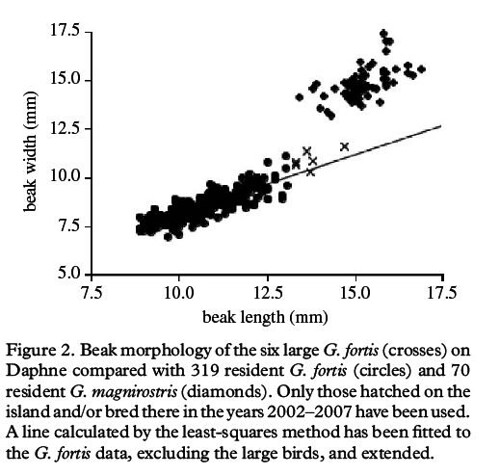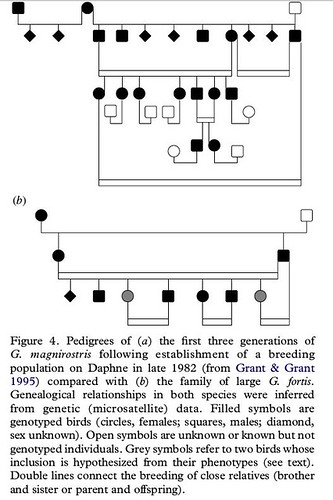tags: evolution, beak and body size, Geospiza fortis, inbreeding, mating patterns, reproductive isolation, sexual imprinting
A family tree depicts the evolution of the 14 species of "Darwin's finches".
(The focus of this study, the Medium Ground Finch, Geospiza fortis, is denoted with a red dot).
[larger image].
I have always been fascinated by the process of speciation throughout my scientific career because speciation is the "engine" that generates biological diversity. But what are the evolutionary mechanisms that lead to speciation? We know that mate choice can be one important barrier to genetic exchange that may be sufficient for the formation of new species, but how is a mate chosen and what influences those choices? In birds, there is an almost bewildering array of visual and auditory cues that can be used to choose an appropriate mate. To begin making sense of how birds use this plethora of cues, Peter and Rosemary Grant, evolutionary ecologists at Princeton University, took the unusual approach of constructing a family pedigree to decipher how a barrier to genetic exchange, such as assortative mate choice, arises in a population of "Darwin's finches."
Darwin's finches are interesting study organisms because they comprise 14 species (see above) that descended from one common ancestor that arrived in the Galapagos Island archipelago within the past 2-3 million years. These birds are still at an early stage of speciation because they are capable of hybridization, although they do so very rarely. However, any resulting hybrids among Darwin's finches are known not to suffer any observable disadvantages to their survival as long as benign environmental conditions predominate on their island homes. So what keeps these 14 identified species from interbreeding until they have merged into one species?
To answer this question, the Grants chose to focus on the nonrandom mating patterns observed in a group of Medium Ground Finches, Geospiza fortis (Figure 1) that have an unusually large body size. These birds are found on the island of tiny uninhabited Galapagos island of Daphne Major;
DOI: 10.1098/rspb.2007.0898.
The abrupt appearance on Daphne of a small population of unusually large G. fortis suggests that these birds recently immigrated. Despite finding themselves living among other, smaller, birds of the same species who sang the same songs, the immigrants maintained their larger than normal body size throughout the ensuing generations, suggesting that they paired assortatively, with larger birds pairing with mates that also have larger body size. As a result, the authors decided that a pedigree analysis would help them document the birds' mate choices.
To do this research, the authors captured, measured and then marked each individual with unique color combinations of leg bands (refer to figure 1) during a three year period of time. Using genetic data and beak measurement datasets, the Grants found that the immigrant population of unusually large Medium Ground Finches were not the result of hybridization between the resident populations of Medium and Large Ground Finches, G. magnirostris.
During this time period, the authors collected the same suite of morphological measurements from the resident population of G. magnirostris. A comparison of the beak width and length measurements for these two species of Ground Finches reveal no intermediate measurements as would be expected if hybridization had occurred recently, which was confirmed with genetic analysis (Figure 2);
DOI: 10.1098/rspb.2007.0898 [larger view].
In two of the three years that the authors documented mate choice among all the birds on Daphne, they found that individuals at each extreme of the population were pairing assortatively: unusually large birds in the immigrant population mated with other large birds (crosses in Figure 3) while the small resident birds paired with other small birds (dark circles in Figure 3);
DOI: 10.1098/rspb.2007.0898 [larger view].
The authors then compared a family pedigree for the resident Large Ground Finches, G. magnirostris (Figure 4a), that first became established on Daphne late in 1982 and found that it closely resembles the pedigree for the immigrant population of unusually large G. fortis (Figure 4b). These pedigrees document that a bird's family strongly influenced its own mate choices; those birds that chose large mates were much more likely to have had large parents (Figure 4);
DOI: 10.1098/rspb.2007.0898 [larger view].
This research identifies an important living example of incipient speciation and provides scientists with the rare opportunity to document how this process occurs. In this situation, the data show that these birds imprint upon the morphology of their parents and rely upon this information preferentially over song when choosing their own mates. Thus, based on these data, the authors conclude that the beginnings of speciation are already present within a single variable population when extremes within the population can be reliably identified. Additionally, this study reveals the importance of pedigree analyses for disentangling and identifying which among a variety of available cues contribute to the formation of new species.
Source
Grant, P.R., Grant, B.R. (2008). Pedigrees, assortative mating and speciation in Darwin's finches. Proceedings of the Royal Society B: Biological Sciences, 275(1635), 661-668. DOI: 10.1098/rspb.2007.0898
Read More About It
How and Why Species Multiply: The Radiation of Darwin's Finches [book review].
Speciation in Birds [book review].






Are you deliberately baiting Wilkins with this? :-)
Isn't that sympatric speciation? I don't see why you need mechanisms for assortative mating in allopatric speciation: the geographical separation should be enough.
Thanks for yet another interesting blog! Keep it up!